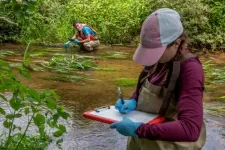(Press-News.org) CAPE COD, MASSACHUSETTS – Earlier this year, the US Environmental Protection Agency proposed maximum allowable levels in drinking water for six PFAS (per- and polyfluoroalkyl substances) – so-called forever chemicals. But the draft standards do not account for half of the PFAS at contaminated sites across the country.
The findings are from a team led by the Harvard John A. Paulson School of Engineering and Applied Sciences (SEAS) and are published in the journal Environmental Science & Technology.
PFAS are present in fire retardant foams among other products and have been building up in the environment since they were first invented by Dupont in the 1930s and manufactured widely by 3M beginning in the 1950s. Exposures to some PFAS are linked to a range of health risks including cancer, immune suppression, diabetes, and low infant birth weight.
PFAS compounds come in two forms: a precursor form and a terminal form. Most of the monitored PFAS compounds are terminal compounds. The EPA’s draft drinking water rules are for six terminal compounds that do not degrade under normal environmental conditions. Precursor compounds can be transformed through biological or environmental processes into terminal forms. There are many precursor compounds, most of which are not routinely monitored, and none are currently regulated.
The U.S. military is the largest global user of fire-retardant foams containing PFAS known as AFFF (aqueous film forming foam). For decades, hundreds of military bases across the U.S. and around the world used AFFF containing high levels of PFAS for fire training drills and fighting fires. AFFF use is one of the largest sources of PFAS contamination in drinking water.
“Many PFAS precursors present in AFFF are difficult to measure. This work shows that they are slowly transforming into PFAS of health concern at AFFF-contaminated sites and contributing to downstream contamination” said Elsie Sunderland, Fred Kavli Professor of Environmental Chemistry and Professor of Earth and Planetary Sciences at SEAS and senior author on the new paper.
Much of the PFAS at military sites consists of precursors that are omitted from standard analytical methods. Using a method previously developed in the Sunderland lab that captures all precursors in AFFF, the Harvard team modeled the expected duration and contribution of those precursors to groundwater contamination. The study finds that contamination of two of the newly regulated PFAS chemicals (perfluorohexane sulfonate: PFHxS and perfluorbutane sulfonate: PFBS) at one military base on Cape Cod, Massachusetts are sustained by microbial precursor biotransformation in the soil. These precursors are retained in the soil where they leach into groundwater in terminal form at concentrations thousands of times greater than the safe levels established by the EPA.
The researchers projected using a computer model and field data that, without remediation, widespread PFAS contamination of drinking water supplies near military facilities is likely to persist for centuries. Despite contamination of nearby aquifers that may already pose a risk to human health, the majority of PFAS are still sitting in the soils surrounding these contaminated sites, emphasizing the urgent need for advances in remediation technology that are effective at cleaning up both terminal and precursor compounds. Since regulations focus only on terminal compounds, the effectiveness of current remediation technologies at cleaning up precursors is not known.
The researchers concluded that elevated PFAS exposures downstream of more than 300 U.S. military facilities that used the fire-fighting foams could similarly persist for centuries.
“The role of PFAS precursors in sustaining hazardous levels of contamination at Joint Base Cape Cod raises concern about whether exposure risks are underestimated near hundreds of other sites where they are not measured” said Bridger Ruyle, the first author of the study and former doctoral student in Sunderland’s Lab.
The public comment period for EPA’s draft PFAS drinking water regulation closes on May 30. While a step in the right direction, there are thousands of PFAS chemical structures, several hundred of which have already been detected in the environment, Sunderland notes.
In related work also published in Environmental Science & Technology today, Sunderland’s group also has shown that the number of military fire training areas within a watershed is a good predictor for PFAS contamination in a community’s drinking water supply. But some groups are at higher risk than others; a forthcoming publication by the Sunderland lab documents marked sociodemographic disparities in exposures to PFAS and proximity to PFAS sources across the country.
Additional authors include Colin Thackray and Chad Vecitis of Harvard; Craig Butt of AB Sciex LLC; and Denis LeBlanc and Andrea Tokranov of the U.S. Geological Survey.
Funding for the research was provided by the Department of Defense Strategic Environmental Research and Development Program (SERDP ER18-1280) and the U.S. National Institute for Environmental Health Sciences Superfund Research Program (P4ES027706). Additional support was provided by the U.S. Geological Survey Toxic Substances Hydrology Program.
END
EPA's new PFAS rules don’t account for major source of drinking water contamination
Harvard study reveals unmonitored PFAS build up and last for centuries
2023-05-15
ELSE PRESS RELEASES FROM THIS DATE:
Communities of color disproportionately exposed to PFAS pollution in drinking water
2023-05-15
Embargoed for release: Monday, May 15, 2023, 8:00 AM ET
Boston, MA – People who live in communities with higher proportions of Black and Hispanic/Latino residents are more likely to be exposed to harmful levels of per- and polyfluoroalkyl substances (PFAS) in their water supplies than people living in other communities, according to a new study led by researchers from Harvard T.H. Chan School of Public Health. The researchers link this finding to the disproportionate siting of sources of PFAS pollution—such ...
WFIRM bioprinting research makes history when it soars to the ISS
2023-05-15
WINSTON-SALEM, NC – MAY 15, 2023 – The Wake Forest Institute for Regenerative Medicine (WFIRM) will make history this month when the first bioprinted solid tissue constructs soar to the International Space Station (ISS) on board the next all private astronaut mission by commercial space leader Axiom Space.
The Axiom Mission 2 (Ax-2) launch by Houston-based Axiom Space is launching from Florida’s Kennedy Space Center. The crew will conduct extensive scientific research experiments including WFIRM’s vascularized tissue research – which won first place in the NASA Vascular Tissue Challenge in 2021.
Liver ...
Smartphone use goes up in city parks, but down in forests
2023-05-15
While a visit to the great outdoors is a common prescription for reducing screen use, a pioneering new study finds that time outdoors doesn’t always reduce smartphone screentime.
The new research, which tracked smartphone activity of 700 study participants for two years, reveals that participants’ smartphone activity actually increased during visits to city parks and other urban green spaces.
With smartphone use rising worldwide, the study clearly identifies a powerful way to reduce screen time: participants who visited nature reserves or forests saw significant declines in screentime over the first three hours, ...
New study finds the placenta, not only the brain, plays a central role in genetic risk of schizophrenia
2023-05-15
BALTIMORE, Md. (May 15, 2023) – More than 100 genes linked to the risk of schizophrenia seem to cause illness because of their role in the placenta rather than in the developing brain, according to a new study led by the Lieber Institute for Brain Development.
Scientists had generally assumed for over a century that genes for schizophrenia risk were principally, if not exclusively, about the brain. But the latest research, just published in Nature Communications, found that the placenta plays a much more significant role in developing illness than previously known.
“The secret of the genetics of schizophrenia has been hiding in plain ...
Wide-ranging strategies needed to eliminate racial and ethnic inequities in stroke care
2023-05-15
Statement Highlights:
In a review of the latest research, few stroke studies addressed racist policies, such as residential segregation, or social determinants of health, such as neighborhood deprivation, walkability or security; food availability; economic stability; education quality; or employment and health insurance, all of which play a role in stroke incidence, care and outcomes.
The statement summarizes research on interventions to address racial and ethnic disparities in stroke care and outcomes.
Additional research is needed to determine ...
Coastal lights trick coral reefs into spawning earlier than they should
2023-05-15
The light pollution caused by coastal cities can trick coral reefs into spawning outside of the optimum times when they would normally reproduce, a new study has found.
Coral broadcast spawning events – in which lunar cycles trigger the release of eggs on certain nights of the year – are critical to the maintenance and recovery of reefs following mass bleaching and other similar events.
However, using a combination of light pollution data and spawning observations, researchers were able to show for the first time that ...
New algorithm can predict diabetic kidney disease
2023-05-15
LA JOLLA, CALIF. – May 15, 2023 – Researchers from Sanford Burnham Prebys and the Chinese University of Hong Kong have developed a computational approach to predict whether a person with type 2 diabetes will develop kidney disease, a frequent and dangerous complication of diabetes. Their results, published in Nature Communications, could help doctors prevent or better manage kidney disease in people with type 2 diabetes.
“This study provides a glimpse into the powerful future of predictive diagnostics,” says co-senior author Kevin Yip, Ph.D., a professor and director of Bioinformatics ...
National Poll: 2 in 3 parents not confident they can tell whether used children’s equipment is safe
2023-05-15
Cribs, strollers and other infant and child equipment can be expensive and most families in a new national poll agree that it’s wasteful to buy these items new when they’re needed for such a short time.
But while half of parents say they have used pre-owned equipment for babies and young children, two in three acknowledge that it’s difficult to always know whether it’s safe for their child, according to the University of Michigan Health C.S. Mott Children’s Hospital National Poll on Children’s Health.
“Used child essentials ...
Managing cardiovascular disease risk factors may help preserve physical function as we age
2023-05-15
Managing cardiovascular disease (CVD) risk factors may play a role in preserving physical function during the aging process, according to new research published today by The Journals of Gerontology, Series A: Biological Sciences and Medical Sciences.
“Approximately 10% of older adults have muscle weakness and diminished physical function that leads to adverse health outcomes and physical disability,” said lead author Dr. Shivani Sahni. “Since loss of physical function contributes to reduced mobility, disability, institutionalization, and mortality, management of CVD risk factors can help preserve physical function with age,” ...
The Endocrine community joins forces on European Hormone Day to raise awareness of vital role of hormones in preventing and treating rare and chronic diseases
2023-05-15
PRESS RELEASE
EMBARGOED TO 15 MAY 2023
Contact: Victoria Withy
Head of Marketing, Communications and Membership
E: victoria.withy@ese-hormones.org
M: +44 (0) 7761 800855
Today, 15 May 2023, the European Society of Endocrinology (ESE), the European Hormone and Metabolism Foundation (ESE Foundation) and other partners are marking the second European Hormone Day.
European Hormone Day brings together all those with an interest in endocrine health and disease to promote a better understanding of the role of hormones and encourage a collective call for change about ...
LAST 30 PRESS RELEASES:
Satellite data helps UNM researchers map massive rupture of 2025 Myanmar earthquake
Twisting Spins: Florida State University researchers explore chemical boundaries to create new magnetic material
Mayo Clinic researchers find new hope for toughest myeloma through off-the-shelf immunotherapy
Cell-free DNA Could Detect Adverse Events from Immunotherapy
American College of Cardiology announces Fuster Prevention Forum
AAN issues new guideline for the management of functional seizures
Could GLP-1 drugs affect risk of epilepsy for people with diabetes?
New circoviruses discovered in pilot whales and orcas from the North Atlantic
Study finds increase in risk of binge drinking among 12th graders who use 2 or more cannabis products
New paper-based technology could transform cancer drug testing
Opioids: clarifying the concept of safe supply to save lives
New species of tiny pumpkin toadlet discovered in Brazil highlights need for conservation in the mountain forests of Serra do Quiriri
Reciprocity matters--people were more supportive of climate policies in their country if they believed other countries were making significant efforts themselves
Stanford Medicine study shows why mRNA-based COVID-19 vaccines can cause myocarditis
Biobanking opens new windows into human evolution
Sky-high smoke
AI tips off scientists to new drug target to fight, treat mpox
USC researchers develop next-generation CAR T cells that show stronger, safer response in animal models
New study reveals Industrial Revolution’s uneven health impacts across England
Vine-inspired robotic gripper gently lifts heavy and fragile objects
Fingerprint of ancient seafarer found on Scandinavia’s oldest plank boat
Lunar soil analyses reveal how space weathering shapes the Moon’s ultraviolet reflectance
Einstein’s theory comes wrapped up with a bow: astronomers spot star “wobbling” around black hole
Danforth Plant Science Center to lead multi-disciplinary research to enhance stress resilience in bioenergy sorghum
Home-delivered groceries improve blood sugar control for people with diabetes facing food insecurity
MIT researchers identified three cognitive skills we use to infer what someone really means
The Iberian Peninsula is rotating clockwise according to new geodynamic data
SwRI, Trinity University to study stable bacterial proteins in search of medical advances
NIH-led study reveals role of mobile DNA elements in lung cancer progression
Stanford Medicine-led study identifies immune switch critical to autoimmunity, cancer
[Press-News.org] EPA's new PFAS rules don’t account for major source of drinking water contaminationHarvard study reveals unmonitored PFAS build up and last for centuries





